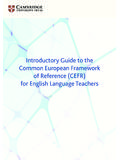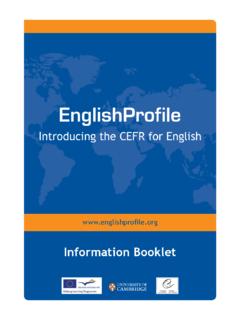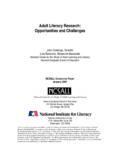Transcription of Introducing the CEFR for English - English Profile
1 Introducing the cefr for English Version 2011 English Profile Introducing the cefr for English This booklet is aimed at ELT professionals, including curriculum planners, materials writers and teachers. It will help you make decisions about which English language points are suitable for learning, teaching or assessing at each level of the Common European Framework of Reference ( cefr ; Council of Europe 2001). Section 1 explains what English Profile is whilst sections 2, 3 and 4 describe how Grammar, Functions and Vocabulary are being researched in English Profile , together with a summary of the latest findings in all three research strands. Section 5 suggests how you can use these resources and section 6 describes where the information in English Profile comes from and how reliable it is.
2 Section 7 explains where you can access more information and resources and how you can get involved with the ongoing development of English Profile , followed by the key references for English Profile research to date and a list of current English Profile Network members. Contents Page Section 1 What is English Profile ? 2 Section 2 The English Grammar Profile 9 Section 3 The English Functions Profile 36 Section 4 The English Vocabulary Profile 53 Section 5 How to use the English Profile 57 Section 6 What is English Profile based on? 58 Section 7 How to get involved with English Profile 59 Section 8 References 60 Section 9 The English Profile Network 63 Acknowledgements: This publication has been compiled from existing resources by English Profile team members at Cambridge ESOL and Cambridge University Press, aided by contributions from academic consultants at other institutions.
3 The production of this booklet was supported by a grant from The British Council. UCLES/CUP 201111 What is English Profile ? The aims of English Profile are: x To set up and manage a collaborative programme of interdisciplinary research to produce Reference Level Descriptions for English linked to the general principles and approaches of cefr . x To provide a core set of reference tools for practitioners working in English language education. English Profile is a long term, collaborative programme of interdisciplinary research whose goal is to transpose the Common European Framework of Reference for the English language ( cefr ; Council of Europe 2001) and for teaching and assessment purposes where English is the language being learned. The intended output is a Profile of English language learners in terms of the six proficiency bands of the cefr A1 to C2 (see Saville & Hawkey 2010).
4 The English Profile Programme will do this by providing Reference Level Descriptions for English to accompany the cefr . These descriptions cover what learners know and can do in English at each of the six cefr levels. English Profile is registered with the Council of Europe and is managed by a core group of collaborators at the University of Cambridge. The research being carried out at the heart of the English Profile Programme is innovative, providing measurable, evidence based answers to important questions about how people acquire English and how they can improve their skills. As well as adding to our understanding of language learning, the English Profile Programme is producing practical outcomes that can be used in the development of curricula, course materials, teaching guides and assessment systems.
5 This publication traces progress and outcomes in three main current areas of research for English Profile : the grammatical, functional and lexical features of learner English . But English Profile will also describe learner English at each cefr level in other linguistic areas, including aspects of spoken language such as pronunciation. An innovative feature of English Profile , distinguishing it from previous work in this field, is that research is based on electronic corpora of learner data, including the largest annotated corpus of English language learner test output in the world: the Cambridge Learner Corpus. This approach is producing results which can be empirically measured and which are not predictable from current language learning theories alone.
6 Researchers are also starting to focus on the impact of different first languages, learning contexts and the effects of language transfer on learning at the different cefr levels (A1 to C2). A steadily growing number of academics, government advisors and educationalists make up the English Profile Network. Network Partners contribute directly to the development of English Profile by providing access to data or contributing to work in progress through participation in workshops and seminars. In summary, English Profile provides essential information for curriculum planners, teachers, materials writers, test developers and researchers. The English Profile Programme aims to provide these ELT professionals with resources, information and events, including.
7 X English Vocabulary Profile (EVP) a rich online vocabulary database by cefr level x English Grammar Profile a database of grammatical structures by cefr level (under development) x English Functions Profile a database of real English examples for various functions in different contexts by cefr level (under development) x English Profile Glossary an online glossary including concise definitions of key EP terminology x English Profile Journal on online peer reviewed journal for EP related research x The English Profile Studies series launched in 2011 this series is dedicated to reporting different aspects of research and development related to the EP Programme x Word of the Week email updates based on the EVP x English Profile Network community website, 2 UCLES/CUP 2011x Presentations at international education, applied linguistics and language testing conferences, IATEFL, AILA, LTRC x Regular EP Research Seminars (annually in Cambridge), EP Network Seminars (twice a year outside the UK) and other workshops.
8 For the latest information about English Profile and news of future events, workshops and publications, see Who has developed English Profile ? The founding partners are: Research is led by Cambridge ESOL and Cambridge University Press, with contributions from the Research Centre for English and Applied Linguistics and the Cambridge Computer Cambridge University Press and Cambridge ESOL are the main funding partners in English Profile . In addition, English Profile has a growing number of Network Partners, including universities, schools, language training centres and government departments, as well as individual researchers and specialists (see Section 9). The development of the cefr The Common European Framework of Reference for Languages is a common framework of language ability divided into six main levels ranging from beginner to advanced.
9 It appeared in its published form in 2001, ten years after the R schlikon Conference of 1991 which concluded that a "common framework of reference" of this kind would be useful as a planning tool to promote "transparency and coherence" in language education. In the decade since its publication this ambition has been achieved to a large extent and the document itself has been translated into 37 languages, widely disseminated in Europe and in parts of Asia and Latin America (see Little 2007 for an overview). It is important to remember, however, that the cefr in that format was intended to be "a work in progress" rather than the finished article. The cefr was therefore envisaged as a planning tool which could provide a common language for describing objectives, methods and assessment in language teaching, as put into practice in diverse contexts for many different languages.
10 It was to facilitate the development of syllabuses, examinations, textbooks and teacher training programmes, and in particular, to stimulate reflection and discussion. As the cefr authors themselves emphasise in their Notes for the user: We have NOT set out to tell practitioners what to do or how to do it. We are raising questions not answering them. It is not the function of the CEF to lay down the objectives that users should pursue or the methods they should employ. (Council of Europe 2001: xi) 1 Part of the Department of Theoretical and Applied Linguistics from August 2011. UCLES/CUP 20113 The six reference levels have been particularly influential and have generated a great deal of discussion in the fields of curriculum development, language teaching, and especially in assessment (see Coste 2007).







